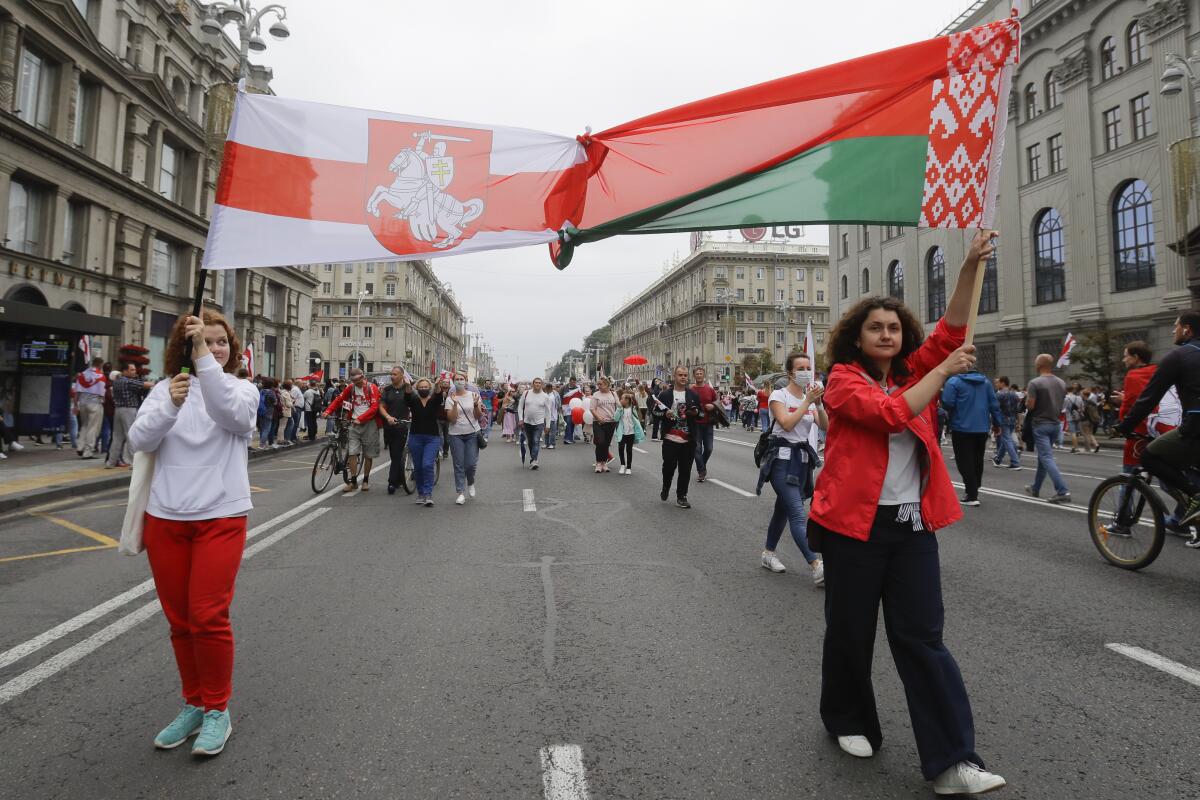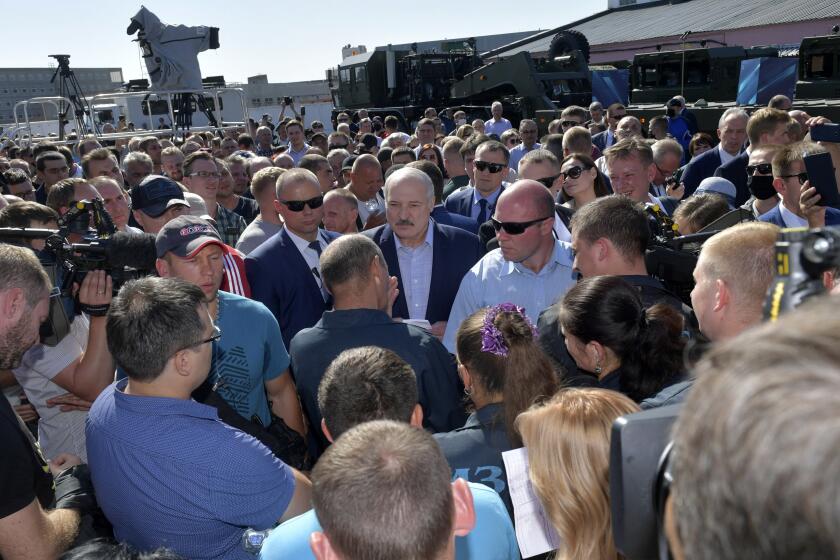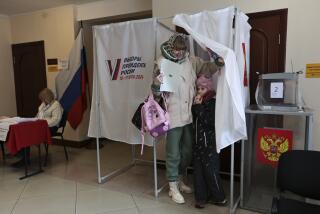Armed Belarus president seen on video as protests roil capital

- Share via
MINSK, Belarus — The authoritarian president of Belarus made a dramatic show of defiance Sunday against the massive protests demanding his resignation, toting a rifle and wearing a bulletproof vest as he strode off a helicopter that landed at his residence while demonstrators massed nearby.
In the 15th day of the largest and most determined protests in independent Belarus, a crowd of about 200,000 rallied against President Alexander Lukashenko in a square in Minsk, the capital. They then marched to another rally and approached the Independence Palace, the president’s working residence.
Video from the state news agency Belta showed a government helicopter landing on the grounds and Lukashenko getting off holding what appeared to be a Kalashnikov-type automatic rifle. No ammunition clip was visible in the weapon, suggesting that Lukashenko, who cultivates an aura of machismo, intended only to make a show of aggression.

Lukashenko brandishes rifle
Protests started Aug. 9 after a presidential election that officials say handed the 65-year-old Lukashenko his sixth term in office with 80% voter approval. Opponents claim the results are fraudulent.
The size and duration of the protests have been unprecedented for Belarus, a former Soviet republic of 9.5 million people that Lukashenko has ruled harshly for 26 years.
On Sunday afternoon, an opposition rally overflowed Minsk’s sprawling 17-acre Independence Square. There were no official figures on crowd size, but it appeared to be about 200,000 people or more.
The demonstrators then marched to another square about 1.2 miles away and approached the edges of the presidential residence grounds, where police in full riot gear stood shoulder-to-shoulder, holding large shields.
The protesters dispersed in the evening amid rain.
There were no immediate reports of arrests. Earlier this month, some 7,000 people were arrested at protests, many of them badly beaten with clubs or wounded by rubber bullets, violence that caused public outrage to swell.
Lukashenko appears to be flailing about for a strategy to counter the anti-government demonstrations.
The workforce at state-run enterprises in Belarus has long been a pillar of support for the country’s beleaguered president. Now that’s changing.
He has repeatedly blamed Western interference, claimed the protests were backed by the United States and accuses NATO of building up troop concentrations in Poland and Lithuania on Belarus’ western border, which the North Atlantic Treaty Organization denies. He also claimed that Russian President Vladimir Putin was willing to offer security assistance to his government to quell the protests if requested to do so.
Lukashenko has consistently repressed opposition during his time in office and weariness with his hard-line rule, as well as dismay over the country’s deteriorating economy and Lukashenko’s cavalier dismissal of the coronavirus outbreak, appears to have galvanized opponents.
“Belarus has changed. Lukashenko has been able to unify everybody, from workers to intelligentsia, in the demand for change,” said protester Slava Chirkov, who attended Sunday’s demonstration with his wife and son.
They held a sign declaring “Lukashenko, your milk has gone sour,” referencing Lukashenko’s former job as the director of a Soviet-era collective farm.
A similarly enormous crowd turned out for a protest a week ago and daily demonstrations have taken place since the vote. Several of the country’s key factories have been hit with protest strikes by workers fed up with government polices. Those strikes not only threaten the already-ailing economy, but show that opposition to Lukashenko extends beyond educated white-collar circles and into his traditional blue-collar base.
“Are you going to work for a dictator? Strike — that’s our answer,” Sergei Dilevsky, leader of the strike committee at the Minsk Tractor Works, one of Belarus’ largest industrial enterprises, told protesters at Sunday’s second rally site.
Lukashenko’s main election challenger, Sviatlana Tsikhanouskaya, fled to Lithuania the day after the election. Several other possible challengers fled the country even before the election.
An opposition Coordination Council was created last week to develop a strategy for a transition of power, but authorities in Belarus have opened a criminal inquiry into its formation.
Also Sunday, more than 50,000 Lithuanians joined hands in a human chain stretching 20 miles from the capital, Vilnius, to the border with Belarus to express solidarity with the protesters.
More to Read
Sign up for Essential California
The most important California stories and recommendations in your inbox every morning.
You may occasionally receive promotional content from the Los Angeles Times.










